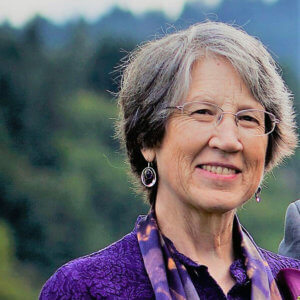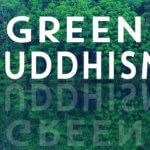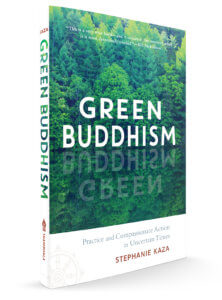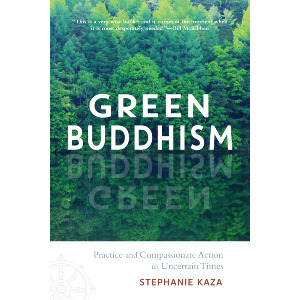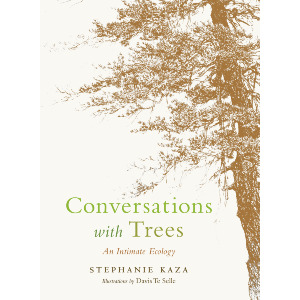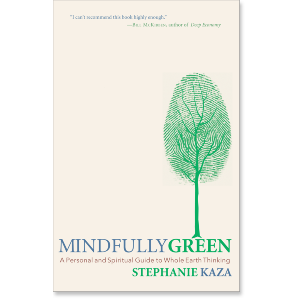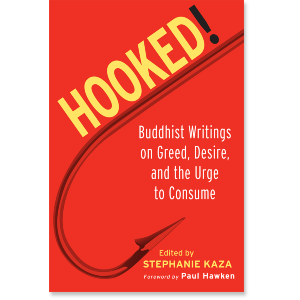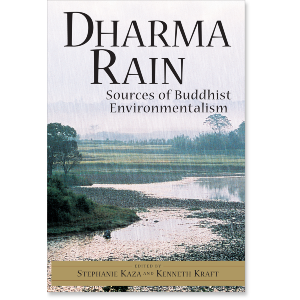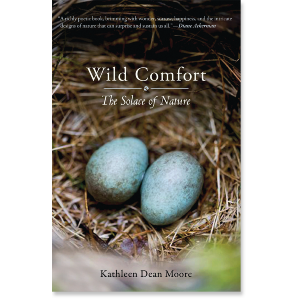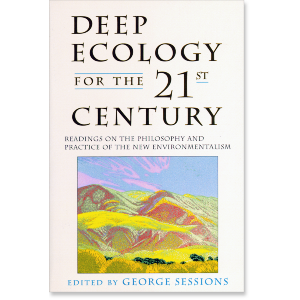An Excerpt from Green Buddhism
Understanding Our Impact
Withdrawing from the Paris Agreement, cancelling clean-water regulations, stalling on clean-energy projects—the recent years under a climate-change-denying political administration have been very discouraging, indeed. Day after day, we seem to hear only about backward steps and policy losses on environmental issues. The more we know about the impacts of climate change and global economic disparities, the more we fear things are going in a terribly wrong direction.
As I have spoken with people in my hometown and around the country, I hear these questions over and over: What can one person do? What should I do? What is most critical now?
I have been struck by the urgent and widespread need to engage with environmental concerns on a personal and local level. Behind the passion is a deeply felt need to do something right, to find a way to correct course before it is too late. I hear the sorrow for all the thoughtless and heartbreaking damage from our shortsighted actions as humans. I also hear a great well of shame and grief wanting relief from this immense emotional burden.
In the midst of so much concern, many people have taken up what I’ve come to call the green practice path. People are growing their own food, commuting by bike or bus, insulating their homes, and passing along green values to their children. They are joining climate marches and campaigning for green candidates. They are thinking carefully about what matters to them, trying to match their actions to their moral convictions. I believe the green practice path is a reflection of the Dalai Lama’s “ethics for the new millennium,” an ethics built on compassion, restraint, and universal responsibility for the well-being of the Earth.
Green Buddhist practices are a part of this ethical effort to build a more mindful, stable, sustainable, and peaceful society. This is certainly a tall order, but every action in this direction counts, and all of it helps stem the frightening tide of planetary destruction.
Contemplative Principles for a Green Practice Path
Under such a tide of threat and uncertainty, it can help to have some core principles as a reference point for ethical action. I would suggest three foundational orientations that draw on Buddhist philosophy to offer a path toward a sustainable future: reducing harm, being with the suffering, and embracing the deep view.
Reducing Harm
The Dalai Lama often begins his speeches by saying, “everyone wants to be happy, no one wants to be unhappy.” Another way to put this is, “everyone wants to be free of harm, no one wants to be harmed.” All beings, from baby grasshoppers to giant redwoods and people the world over, would prefer to be safe, to be free from violence, and to be allowed to live their lives in peace. Reducing harm through mutual respect is fundamental to keeping human societies functional and not self-destructive.
This principle of nonharming applies to both human-to-human relations and also to human relations with places, and the beings within the places. It is difficult for ecosystems to thrive if plants and animals, groundwater, streams, mountains, oceans, and air are constantly under assault. Human beings trying to live in damaged or ailing ecosystems do poorly as well.
What does it mean to reduce harm?
We don’t always know when harm is being done, and even if we can see there is harm, we don’t always know what the cause is. And further, there may be a number of reasons why it is difficult to reduce the harm that is happening. Taking up the ethical path of reducing harm turns out to be a complex and demanding practice.
By “practice,” I mean engaging the questions around harming for a period of time and asking them over and over in different contexts. It is a form of discipline, bringing the attention back to the questions with a fresh mind again and again.
If our spiritual goal is to reduce harm in the world, we must ask such hard questions as: What do I actually need? What is my fair share? How do my choices impact others?
Questions like this are not meant to be answered quickly or completely. The point is to contemplate these hard questions with full attention and see where they lead you, being ethical but also realistic. In Zen this sort of question is called a koan, a continually unfolding puzzle that takes more than mental effort to answer. You live with a koan, you wrestle with it, you get stumped by it, you have sudden breakthroughs with it. Over time, the green practice path supports a larger view, transforming our inner orientation to everyday life.
Buddhist monks and committed laypeople take vows to uphold specific ethical guidelines. The first of these formal Buddhist precepts is stated unequivocally: do not kill. It is considered a serious ethical injunction aimed at protecting life. In Mahayana Buddhist traditions, nonharming is known as the great vow, the bodhisattva vow. A bodhisattva is a “heroic benefactor” and guide, an archetype of liberating energy, a figure who embodies tremendous motivation for helping others. The bodhisattva vow is a pledge to reduce suffering and to care for all beings in whatever way possible. Making such a vow is a statement of intention; the vow itself helps to strengthen that intention.
Reducing harm is inner as well as outer work for those on the green practice path. One practices also to reduce harm to one’s own mind and body. This precious self—the one who wants to be a good eco-neighbor on this planet, the one who struggles with the dilemmas of nonharming—they, too, are in need of kindness.
Practicing kindness to yourself is essential in taking up the path of nonharming.
A strong wish for the well-being of others can be grounded in a strong wish for your own well-being. This is not really being selfish, it is being practical. The greater the care we give ourselves, the more able we are to take on challenges for and with others. The more clear and calm our minds, the more we can see how to act ethically in a given situation.
Being with the Suffering
Even with all our best efforts, it will still be impossible to eliminate all of the harm being done to the world. The scale of environmental suffering is too widespread and too deeply entrenched. Many things have been set in motion long before our time. Many situations are simply out of our control.
While we can do our best to reduce the harm associated with our own actions, we are limited in how much we can reduce the extensive harm caused by others. How do we cope with this sobering recognition?
As we deepen our contemplation of suffering, we want to know why an individual or ecosystem is ailing, especially if the consequences may be significant. If we can make the correct diagnosis of the ailment, then we can find an appropriate course of healing. In Buddhist philosophy the most basic diagnostic method is expressed as the Four Noble Truths, one of the first teachings of the Buddha after his profound awakening. The first noble truth points to the indisputable existence of suffering, that all beings are subject to suffering through birth, illness, old age, and death. Nothing is really permanent; the fact of continuous change means there will be some suffering in the simple effort to stay alive. The second noble truth urges the practitioner to look deeply into the cause of the suffering at hand. This suggests a method for tracing cause—looking to see who and what is involved in the situation. Identifying root causes can become a powerful form of truth telling, holding agents ethically accountable for the consequences of their actions.
The third noble truth states that there can be an end to the suffering. This is a message of hope and healing: it is possible to address the causes determined in the second diagnostic step. Here we find strong affirmation of a complex universe in continuous flux. With multiple potential players and outcomes, something can happen that changes the current state of things for the better. But how to act? The fourth noble truth describes a wheel of eight spokes—right livelihood, right speech, right action, and so on—that offer places to practice healing. Right or skillful actions lead to happiness and well-being; unskillful actions lead to unhappiness and discontent. Skillful action requires clear intention and some understanding of cause and effect. To motivate that action, the suffering must call to you in some way.
Painful as it may be, witnessing the suffering of the world can impel us to step out of our small lives and respond to the driving issues around us with strong motivation.
Embracing the Deep View
In traditional Chinese painting, landscape scrolls convey detailed images from multiple perspectives, offering the viewer many ways to enter the landscape. We are invited to engage the intimacy of the near view in riverbank scenes or a small tea shelter. Our eyes lead us to glimpse the high view from mountaintops and waterfalls. But the paintings also include a third perspective, what is called the “deep view.” Here we look deep into the painting to see the inner folds of the mountains, the ridges behind ridges understood not literally, but in the mind’s eye. Embracing the deep view means looking beyond what you see at first glance to what is hidden behind the observable.
Austrian biologist Ludwig von Bertalanffy was one of the first to articulate this deep view in the West. He called it “a way of seeing.” Working in the 1930s, he found that reductionist approaches to biology fell short in describing organism behavior. He saw each plant and animal as a whole, not so much a “thing” as a pattern of flows in space and time. He characterized nature as an open system, with flows of matter, energy, and information passing through constantly. His term for this was Fliessgleichgewicht, which means “flux-balance.”
A similar view is expressed in Chinese philosophy, that the cosmos consists of dynamic energy fields, constantly in flux and permeated by ch’i, which can be translated as “vital force or power.” This flowing energy fills the universe and is present in all material forms. From moment to moment, it is constantly transforming, shape-shifting, becoming, unfolding. The Chinese term to match Bertalanffy’s flux-balance is sheng sheng puyi—“incessant activity of life creativity.” Such a dynamic system view can help us to think about not just ecosystems, but also social systems, economic systems, and political systems.
If we take a deep view based in the ever-flowing ch’i, we can see ourselves as key players whose actions generate significant consequences.
Looking closely at our situation, it becomes obvious that we don’t exist apart from these systems. Seen through the Chinese worldview of flowing ch’i, our “self” is a flowing stream of information and communication with all those we live with. Some people have called this the “ecological self” or the “true self.” Vietnamese Zen teacher Thich Nhat Hanh speaks of “interbeing,” the self that coexists and co-arises with all other life. There is something very important here that can counter the terrible mountain of despair and helplessness we may feel in facing the overwhelming evidence of environmental abuse. It is remembering that each of us is a participating agent in these flowing streams, that each of us helps shape the streams through our action and feedback. Even as the deep view is shaping us, we are shaping the deep view and all that lies behind it.
Following the Green Path
Reducing harm, being with suffering, embracing the deep view—these three principles provide a practical and philosophical orientation to the green practice path.
Keeping these in mind, we can see how they might guide our steps along the path. But what exactly is that path? How do we understand what it means for us personally to be on a green path?
Around my home are a number of small figures of the bodhisattva Kuan Yin, an archetype of compassion and skillful means. In her hands she offers various means of assistance—a wish-fulfilling jewel, a vessel of soothing water, a lotus of merit. Some of the more elaborate Kuan Yin statues have up to a thousand arms, all ready to help in any way possible. One especially striking version of the icon is the Eleven-Faced Avalokitesvara, which features a stack of heads, each with three faces. Those facing to the front are calm and serene, radiating kindness. Those on the left are wrathful and stern, while those on the right have fangs to protect the earnest seeker. The devoted bodhisattva works tirelessly to save the many suffering beings, but each time she looks back, she sees even more beings arriving to take the place of those she has saved. This causes her head to split apart with grief. Over and over her head splits apart, each grief greater than the last. After the tenth time, the benevolent Amitabha finally gives her his own head, and she is able to continue her tireless work.
This seems to me to describe the green practice path.
In the middle of trying to do something useful for the Earth, you feel alternately calm and wrathful, or protective of what you’ve accomplished. You think you are following a practice path with clear intention, but the challenges seem only to multiply beyond your capacity. Your head or heart may be splitting apart with grief, but then others come forward to help and you return to the work. Each choice, each reflection, each consideration of what is appropriate nourishes the inner personal transformation that comes from taking up a path of practice.
Such a practice commitment may require a re-sorting of personal priorities. Every day and every hour we are making choices that reflect our current priorities. We choose to invest our time, energy, money, relationships in certain things over others.
Thinking green may mean examining our current patterns and seeing if they really reflect what matters most to us.
If green concerns come to occupy more of your everyday thoughts and activities, then it makes sense to move them more into the forefront. It is not possible to do it all, no matter how concerned you are. So you must make some strategic choices to guide your next steps.
Along with this re-sorting will be some inner reflection on the big picture: What is really important now, both in my own life and in the world? How do I keep my attention on what really matters? When I was preparing to take lay ordination vows in the Soto Zen tradition, my Zen teacher, Kobun Chino Otogawa, had me sit quietly all day by myself, thinking about what it meant to take these vows. I read the Buddhist precepts and recited the three refuges, settling my mind on accepting this commitment as best I could. In late afternoon I took a long slow walk in the New Mexico landscape, preparing to cross through the gate of ordination. The next day I repeated my vows in the presence of the local Zen community and received affirmation from my teacher. Afterwards a senior student called in to offer me congratulations. He explained that before ordination I had been practicing primarily for myself to improve my own physical and mental well-being. Now, with these vows, my practice would be primarily in the service of others.
I have come to see environmental work like this, as service on behalf of all beings. Looking at the Big Picture for the Earth means understanding fully the nature of current threats, the need for justice to support sustainability.
We cannot do effective environmental work without examining the role of race, class, gender, power, and privilege in perpetuating environmental damage and inequity.
The green practice path cannot be only a white-culture practice path. Thinking “green” now requires us tothink in all colors of the human rainbow and actively examine the assumptions and roots of environmental privilege. The same entrenched patterns of domination that have undermined the health of the natural world have also cut deep wounds in many communities of color. Dialogue and vigorous self-reflection are necessary starting points for a fully inclusive green practice path.
Engaging Skillful Effort
If we do take up the green practice path, we inevitably encounter obstacles and setbacks that are part of doing environmental work. Fear of strong emotions, fear of feeling guilty or powerless, fear of distressing others—these all prevent people from responding to environmental abuse. We don’t know what to do with the feelings that rise up strongly as we hear about another pipeline spill or another nuclear energy disaster. Something inside us shuts down in a protective way. Enough is enough, the mind says. Don’t tell me about one more bad thing.
Buddhist psychology takes these mind states seriously as a crucial part of the practice path, providing skillful means for working with them. Contemplating difficult emotions directly is useful grounding in the midst of challenging environmental work. In the Buddhist teachings, feeling states are described as pleasant, unpleasant, or neutral. Being on a wooded mountain trail breathing fresh air awakens pleasant feelings; driving by a pulp mill with toxic fumes awakens unpleasant feelings. The pleasant feelings are attracting; they pull us toward the thing that has stimulated those feelings. The unpleasant feelings are repulsing; they push us away from the stimulating thing or thought. Neutral feelings pull us neither way, as when we feel confused or stuck.
Buddhist teachers speak of the Three Poisons—greed, hate, and delusion—as the feelings that most disturb the mind. These terms describe the three tendencies related to our feelings—to go toward what we want (greed), to turn away from what we don’t want (hate or aversion), and to be stalled by what we don’t understand (delusion).
The challenge of the green practice path is to be aware of these feelings and watch how they work in the mind, even though this may be uncomfortable at times.
By staying present in the actual moment of the difficult mind state, we engage it directly and can observe how it affects us. The goal in this practice is to conserve energy—our own energy, that is. We want to minimize the loss of energy to mind states that distract and drain us. We can’t afford to spend weeks or months lost in despair or anxiety.
How then, do we learn to “be with” these difficult mind states? How do we learn to practice with these obstacles without being swept away by their power? A first step is naming the mind states as they arise. Some people practice this naming in the quiet space of meditation. Taking time to be with the feelings generates familiarity with your own personal triggers around environmental concerns. By focusing on awareness of the feelings rather than on the passion, you cultivate equanimity and mental stability for more challenges ahead.
Working with Obstacles
What might this practice look like if we apply it to a difficult environmental concern? Buddhist activist Joanna Macy has developed a process that works with emotions as bound energy, capable of transformation. Originally called “despair and empowerment work,” her guided exercises help people acknowledge their pain for the suffering of the world under assault. Through simple questioning, listening, and guided activity, people are invited to express what they have been feeling. Macy encourages people to see that strong feelings are a compassionate response to the world, a form of energy that can be freed up for constructive action. When we recognize our feelings honestly and clearly, we arrive fully in the present moment, accepting that this is how it is right now. We can then take the next step of shifting from our usual self-absorbed perspective to the deep view, recognizing the big system energy flows we are participating in all the time. This new perspective generates a natural transformation from bound pain to unbound creativity.
We can try this out with the topic of climate change by using one of Macy’s exercises that is based on the Tibetan meditation practice of tonglen. We begin by tuning in to the breath, visualizing the ribbon of air that moves through the nose, into the chest and abdomen, sensing the breath stream as it moves in and out, connecting us with the larger web of life. Then we imagine in our mind’s eye the hardships we know already that are a part of climate change—flooding in Houston from Hurricane Harvey, melting ice in Greenland, polar bears adrift on icebergs, coral reefs bleached by warming seas. Fear arises, we breathe through. We call to mind the harsh droughts in California, the terrible fires and strong winds. Despair arises, we breathe through. We think of island peoples driven from their homes by ocean flooding. Anger arises, we breathe through. As we breathe, we stay present with ourselves. We pay attention while the waves of feeling present themselves. When a wave of feeling subsides, we return to the stabilizing breath, the sense of being connected with the wider web of life. The breath becomes a direct aid to both observing and letting go of obstacles
Many moments of skillful effort on the green practice path add up to a lifetime practice of mindfulness.
Ethical and spiritual engagement offers tremendous support for environmental work. His Holiness the Dalai Lama recommends cultivating the habit of inner discipline. In his book, Ethics for the New Millennium, he points out that lack of inner restraint is the source of unethical conduct. Inner discipline is a voluntary and intentional effort exemplified in the practice of skillful effort. Working with difficult mind states is part of the practice of inner discipline. By dealing with our own difficult mind states, we come to understand that all human beings must grapple with these things; it is core to what makes us human.
Seeking Wisdom Sources
Environmental caregiving is clearly a lifelong task; the changes that need to happen will take generations of effort. We absolutely cannot do this work alone. We need the encouragement and inspiration of others. We need the guidance of those ahead of us on the path, those with green wisdom that can help us find our way. The green practice path is a long road with many kind beings along the way. Just as the obstacles are everywhere, so too are the teachers.
Some years ago, I enrolled in a seminary program to explore my own need for wisdom sources and consider a professional career in the ministry. One course was a private tutorial on the Gospels of Jesus, introduced by reading Martin Buber’s I and Thou. Each week the professor would clear his desk, light a small candle, and invite me to consider the “green circuitry” of meaning that flowed from what I was reading. I wondered aloud to him if Jesus loved trees as Buber did. I wanted to spend time with trees and ask that question in their presence, to see what could happen if you approached trees as wisdom sources. To “hear” the trees, I had to clear my mind as best I could of human projection. In this my Buddhist practice was very helpful, though I struggled with expressing my experience in human language.
On one winter outing I felt called to visit the coast redwoods down in the creek near my house. When it started to rain, I sought shelter in the stump of an ancient old-growth tree, cut perhaps a hundred years ago and charred on the inside from passing fires. I stayed with the old tree, stretching my mind back into the history of redwood destruction. I tried to listen to the whole story—the logging camps, the settling of the West, the rebuilding of San Francisco after the fires, the efforts to protect the remaining giants. Tears of sorrow streamed down my face in the rain, my body shook with sadness for the loss of the elders. And yet, right in the middle of this soaking grief, I felt the true presence and wisdom of the redwood elders rising up to meet me in the hollowed stump.
The wisdom-seeking process is not a single path or a predictable path. As the Tao Te Ching states: “The way that can be followed is not the constant way.” The way is open in all directions, no obstacles. It may not be what we think it is. Wisdom comes from seeing through the limiting frames of feeling and perception, seeing through the limiting constructions of ego that keep us stuck in despair. The green wisdom teachers are everywhere in the infinite universe, available simply for the asking. A friend of mine found such wisdom in the small worlds and complex structures of mosses, ancient beings of the Pacific Northwest forests. Under the macro lens of his camera, the perfect detail of spore capsules and feathery fronds revealed an elaborate field of stunning beauty. Keeping company with mosses has given him a rich source of overlooked wisdom in the order of the natural world.
Share
Related Books
$18.95 - Paperback
$21.95 - Paperback
$17.95 - Paperback
$24.95 - Paperback
$34.95 - Paperback
$19.95 - Paperback
Deep Ecology for the Twenty-first Century
$45.00 - Paperback
